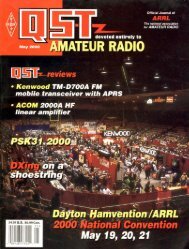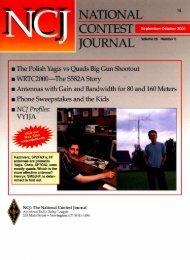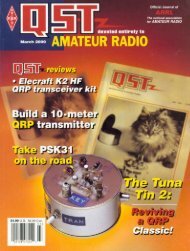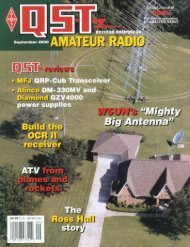You also want an ePaper? Increase the reach of your titles
YUMPU automatically turns print PDFs into web optimized ePapers that Google loves.
By L. B. Cebik, W4RNL<br />
A Beginner’s Guide to<br />
Modeling with NEC<br />
Part 1: Getting settled and getting started<br />
ntenna modeling has become a<br />
A<br />
popular engineering and amateur<br />
activity. You can see the results<br />
in almost any issue of <strong>QST</strong>.<br />
Among the modeling products you might<br />
encounter are azimuth patterns, such as<br />
Figure 1, or elevation patterns, such as<br />
Figure 2, or even an SWR graph, such<br />
shown in Figure 3. Almost every ham knows<br />
that antenna-modeling software is available<br />
at reasonable prices. So only two important<br />
questions remain:<br />
1. Can I model antennas, too Can I<br />
master the software and produce the same<br />
kinds of results that I see in <strong>QST</strong><br />
2. Is antenna modeling worth the effort<br />
Does antenna modeling really offer me any<br />
information that I cannot easily get<br />
elsewhere<br />
The answer to both questions is a<br />
definite “yes.” With a little coaching and a<br />
little practice, virtually any ham can<br />
effectively model many kinds of antennas.<br />
The result will be a better understanding of<br />
one’s own antennas and of antennas in<br />
general. The purpose of this 4-part series is<br />
to provide the “little coaching” part of the<br />
effort. The practice is up to you.<br />
In this first episode, we’ll try to<br />
understand what antenna modeling is and<br />
become oriented to the many parts of a good<br />
antenna model. In future episodes, we’ll take<br />
a closer (but still incomplete) look at crucial<br />
details that will make the task smoother and<br />
the output more understandable.<br />
In all of our work, we’ll focus our<br />
attention on the antenna-modeling core<br />
known as NEC-2. This public domain<br />
software is the heart of numerous commercial<br />
implementations that provide ways for<br />
the user to input data and also that supply<br />
tabular and graphical outputs. There is<br />
another modeling core called MININEC.<br />
Rockway and Logan developed it when PCs<br />
could not handle the Fortran of NEC. There<br />
are two versions available, a public domain<br />
version and a totally revised proprietary<br />
34 <strong>November</strong> <strong>2000</strong><br />
Figure 2—An (EZNEC) elevation pattern<br />
for a dipole at 70 feet above average<br />
ground at 7.15 MHz with an azimuth angle<br />
of 0 degrees.<br />
Figure 3—A (NEC-Win Plus) SWR graph<br />
for a 40-meter dipole at 70 feet above<br />
average ground.<br />
Figure 1—A (NEC-<br />
Win Plus) azimuth<br />
pattern for a dipole<br />
at 70 feet above<br />
average ground at<br />
7.15 MHz with an<br />
elevation angle of<br />
27°.<br />
version. 1 The nature and limitations of<br />
MININEC have been covered in past ARRL<br />
publications, and so they need not be<br />
repeated here. 2<br />
Our focal software, NEC-2 is neither the<br />
newest nor the oldest modeling software. 3 It<br />
is the latest public domain core available and<br />
appears in several commercial implementations,<br />
as well as in “raw” form that one can<br />
download from more than one ftp site. For<br />
the beginner, one of the commercial versions<br />
is recommended, since the raw form requires<br />
that the user develop appropriate input and<br />
output systems. 4 I happen to have two<br />
different commercial versions of NEC-2—<br />
EZNEC 3.0 and NEC-Win Plus. Therefore,<br />
without prejudice toward or against any<br />
version, I shall be illustrating these<br />
guidelines by alternating among the<br />
programs I have. Figure captions will<br />
identify the program used for each graphic.<br />
What is Antenna Modeling<br />
One common misconception of antenna<br />
modeling is that it is similar to making model<br />
boats and cars. The result sort of looks like—<br />
1<br />
Notes appear on page 38.

















